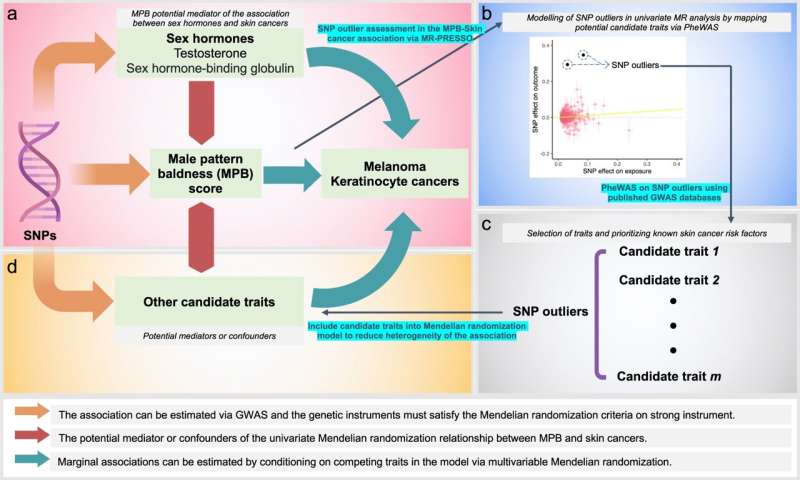
Researchers from QIMR Berghofer have uncovered compelling new evidence that establishes why people with hair loss can be more susceptible to deadly skin cancers.
The researchers led a comprehensive investigation into the relationship between male pattern baldness and skin cancers,. Their findings are published in the journal Nature Communications.
Hair loss is associated with higher rates of skin cancer, and the QIMR Berghofer team wanted to understand why and either confirm or overturn long-standing assumptions. Lead researcher Dr. Jue-Sheng Ong said they were particularly interested in whether the link was driven by testosterone or sun exposure.
“Testosterone levels are a major driver of male pattern baldness, and some studies suggest they may also contribute to this increased skin cancer risk in people with hair loss,” said Dr. Ong.
“The more obvious explanation would be that people with hair loss receive greater sun exposure to their head and neck.
“We sought to find clear answers, and unsurprisingly, it appears the more common-sense explanation is the correct one. Balding men are more susceptible to sun damage and skin cancer because they have less hair protection.”
While the explanation may seem self-evident, the research team needed to run extensive genetic analyses to provide evidence-based insight into the relationship between baldness and skin cancer.
“It’s important that we investigate and prove causality to inform the best evidence-based prevention for deadly skin cancers—even if the answers seem obvious,” said senior researcher, Associate Professor Matthew Law.
“Health programs and interventions cannot be guided by assumptions. They need to be backed by evidence if they’re to work.”
The researchers analyzed genetic data from more than 29,000 cases of melanoma and keratinocyte cancer, available from the landmark QSkin Study and Melanoma Institute Australia.
They also incorporated large-scale genetic findings on testosterone and hair loss, to establish whether genes that predispose people to high testosterone or balding affect skin cancer risk.
The analysis confirmed a strong link between balding and skin cancers, and found this was predominantly due to greater sun exposure. However, genes linked to hair loss and skin color also appear to play a role.
“We found no evidence that testosterone levels play any meaningful role in the relationship between balding and skin cancer,” said Dr. Ong.
“Interestingly, we did find an overlap between genes which cause hair loss and genes which affect skin color or pigmentation. Skin color is a known risk factor for skin cancer, and these results suggest pigmentation may also contribute to this increased risk in people with hair loss.
“However, the majority of this relationship between balding and skin cancer is still explained by increased sun exposure.”
The genetic findings were supported by further analysis of skin cancers in people with hair loss, categorized by anatomical region. It found that balding is associated with an elevated risk of developing skin cancers in the head and neck region, as people with hair loss are likely to receive more sun exposure around these body parts.
Melanoma Institute Australia Co-Medical Directors, Professor Richard Scolyer AO and Professor Georgina Long AO, said research into the genetic drivers of skin cancer was critical.
“Australia has the highest melanoma rates in the world, with one person diagnosed every 30 minutes, so greater understanding of which groups in the population are at increased risk helps us target them with preventative and early detection strategies,” Professor Long said.
“Regardless of individual risk, sun safety is paramount for all Australians as protecting against over exposure to UV is the single most important preventative measure against melanoma and other skin cancers,” added Professor Scolyer.
More information:
Jue-Sheng Ong et al, Uncovering the complex relationship between balding, testosterone and skin cancers in men, Nature Communications (2023). DOI: 10.1038/s41467-023-41231-8
Journal information:
Nature Communications
Source: Read Full Article


